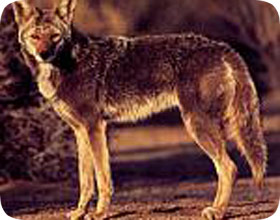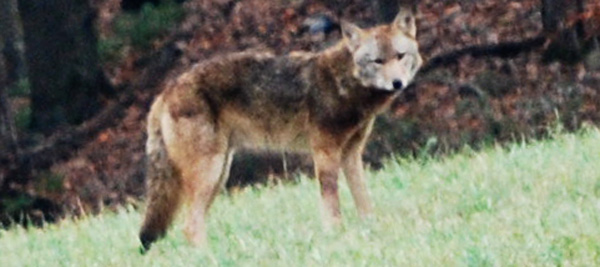- info@wildlife-removal.com
Call us for help in your town
Wildlife Removal Education
Coyote Removal and Control
Need coyote removal in your hometown? We service over 500 USA locations! Click here to hire us in your town and check prices - updated for year 2021.
 Coyote are usually classified as a pest species due to their predation habits. The most common complaints include the following:
Coyote are usually classified as a pest species due to their predation habits. The most common complaints include the following:
- Coyotes preying on sheep
- Coyotes preying on chickens
- Coyote posing threat to pet
- Fear of coyote threatening people
COYOTE NUISANCE CONCERNS:
Coyote’s cause a lot of damage as they kill and eat the domesticated animals including goats, sheep and cattle. In the rural areas, they damage the pipes carrying water for irrigation. Coyotes are well adapted to living around humans and use the food sources provided by humans regularly. They will eat pet food, chicken eggs, crops and gardens and whatever else they can get a hold of easily. Though they generally do not attack humans, the number of attacks has certainly been on the rise in recent past.
DISEASES CARRIED BY COYOTES: Diseases Carried by Coyotes
Coyotes carry Canine parvovirus and viruses for rabies. Though Canine parvovirus does not affect humans, rabies can certainly be transmitted in case of a bite. Caution must be maintained in case you come across coyotes and immediate consultation with a doctor is recommended in case of a bite.
HOW DO I GET RID OF FOX & COYOTES?
The best method is trapping and removal. Many wildlife control specialists excel at canine trapping. In many areas, it's a lost art, since not as many people fur trap as in ye olde days. However, many nuisance trappers
have learned to adopt the fur trappers' techniques in order to catch these animals. Some wildlife operators are in fact former (or even current) fur trappers. There are many techniques, some of which I consider inhumane,
and some of which are antiquated. I have written a coyote trapping tips guide
with various methods. You can also read about how to get rid of coyotes in various specific situations.

CAN'T I JUST USE A COYOTE REPELLENT?
There is no known effective repellent or deterrent device to keep coyotes off of a property. However, there are steps you can take
to keep them away. Please read my coyote prevention and repellent review page or the guide, Best Ways to Repel Coyotes.
COYOTE BIOLOGY:
The coyote is a canine species also known as American Jackal or Prairie Wolf. There are a total of 19 subspecies known to man. Of the 19 species, 16 of them are found in Canada, US and Mexico while the other three are in Central America. They shed their fur once in a year and are known to have proportionally large ears as compared to their head, and small feet as compared to the rest of the body. Their brain/skull size is roughly the same as a domestic dog. Coyotes living in the mountain regions tend to have darker fur than those living in other territories.
A coyote’s body length varies from 76 cm to 78 cm while their tails range from 30 cm to 41 cm. Their height from the ground is around 58 to 66 cm and a normal adult weighs around seven to 21kgs. Coyotes can hear sounds with frequencies as high as 80 KHz. They can sprint at around 69 km/ hour and jump a distance of around 13 feet with hardly any effort.
Coyotes generally travel and hunt in small groups (packs) of six to eight having adults as well as young in the pack. They are considered full grown by the time they are a year old. Although they usually prefer to travel and hunt at night, you might come across a pack in the day time as well. They are capable of digging burrows but are generally found living in those made by other animals such as groundhogs or American badgers.
COYOTE HABITAT:
Coyotes live in dens with an entrance usually 13 inches high and 10 inches wide. The nesting area is situated three to four feet under the ground, is three feet wide and can be reached by a 30 foot long tunnel. Coyotes are actually pretty clean and like to keep their dens clean as well. The mother coyote generally makes two to three dens before giving birth so that she can move her pups to a safe place in case of predator threats or attacks. Also, a den has two or more entrances so that they can escape easily if there is any risk.
Coyotes live wherever the food supply is best. They quickly adapt to most habitats and environments and live, for the most part, easily around humans who provide them with an excellent amount of food resources. This knowledge will help when you want to know
how to catch a coyote.
COYOTE LIFE CYCLE:
The female fertilization cycle lasts for two to five days and can start anywhere between the end of January to March. The sperm formation in males takes around 54 days and occurs in the month of January and February. The gestation period is of 60 to 63 days and the mother coyote gives birth to one to 19 pups at a time. However, more than 50 percent of pups die before they reach adulthood. They weigh about 250gms at the time of birth and are blind. They open their eyes in 10 days and come out of their dens in around 21 to 28 days. Both parents take care of the pups. While the male pups move out of the house after reaching an age of nine to 12 months, females stay with their parents and become the base of pack.
The pups reach sexual maturity at the age of 12 months. Some people have asked me if it's possible to keep a pet coyote, so I've written about the subject.
I don't advocate lethal control of wildlife, and in the case of coyotes, I think they're better off just left alone. However, if you're having an un-resolvable conflict,
such as repeated chicken coop killings, in some cases lethal control is a more practical solution. Thus, I have this how to kill a coyote page for you to read.
Coyotes
Coyotes resemble the domestic dog in size, being smaller in size than the wolf, another member of the Canidae family. The average coyote weight ranges between 20 to 40 pounds, with the females weighing less than the males. They measure between two to three feet tall, and an average of four feet in length. The main coat color associated with coyotes is light tan. Other color variants include grey, red, white, and dark brown with dark spots all over their body. Read the full guide About Coyotes.
The coyote has a pointy nose and ears that detects movements up to 40 yards away during snow season. It also has a bushy tail, with limbs resembling that of other animals of the dog family. The tail has a distinctive black tip.

Behavior
Coyotes are human shy, they are always nervous around humans. It is a nocturnal creature and is known to make distinct vocal sounds similar to that of a crying baby or a dying animal at night.
The Coyote hangs its tail down between their legs when running, unlike the grey wolf that holds its tail up. They are fast runners and can run up to 40 miles (64 kilometers) an hour. In the fall and winter, they form small groups called packs for more effective hunting.
Coyotes form strong family groups. In spring, females den and give birth to litters of three to twelve pups. Both parents feed and protect their young, with the male going out to hunt for food and bringing it back to his family. The parents also protect the territory together, marking the boundaries with urine.
Habitat
Coyotes are highly adaptable animals and can survive almost anywhere on the globe. In rural areas where there is a lot of cover, coyotes can be found on high hills, and open expanses where they leave trails of their path. In other cases, they have been known to forcefully take over the dens of foxes, woodchucks or badgers.
They are also widely found in urban areas despite being shy and edgy around humans. Their presence in any human environment is often marked by porch invasions at night and preying on household pets and livestock. Read the guide Ways to Remove Coyotes from Sheds or Porches.
Cougars and gray wolves, besides man, are the natural predators of coyotes and they are able to reduce the population of coyotes significantly, although coyotes live a communal life especially when they intend to devour a large carcass of food.
Reproduction and Life Cycle
Coyotes live in small nuclear families. These families are formed in midwinter, when the female is in heat. The female gives several mating calls (howls) to attract several males, out of which she selects one to pair with. They are largely monogamous animals and mating takes place once in a year.
After copulation, the gestation period lasts for about 63 days, after which the female gives birth to a litter of 6 pups in average. The pair of male and female mated coyotes usually stay together for a long period of time and not forever as previously misconstrued.
Despite being sworn enemies with the grey wolf, coyotes have been known to co-habit and mate with the wolf to produce hybrids called ‘coywolves’.
Diet
Coyotes are primarily carnivorous; they hunt and feed on small animals like mice, cats, rabbits, birds, fish, and groundhogs. When these small animals are unavailable, coyotes feed on carcasses and forage from garbage cans. Where the carcass is big enough, coyotes tend to form a group to tear down the large food source.
When meat is not available, the highly adaptable coyotes feed on fruit and vegetation. For their hunting strategy, coyotes stalk, hunt in packs and set traps for other small animals. While hunting, coyotes can leap to as much as twice their height over a fence to reach their target prey.
Go back to the Wildlife Removal home page.


















